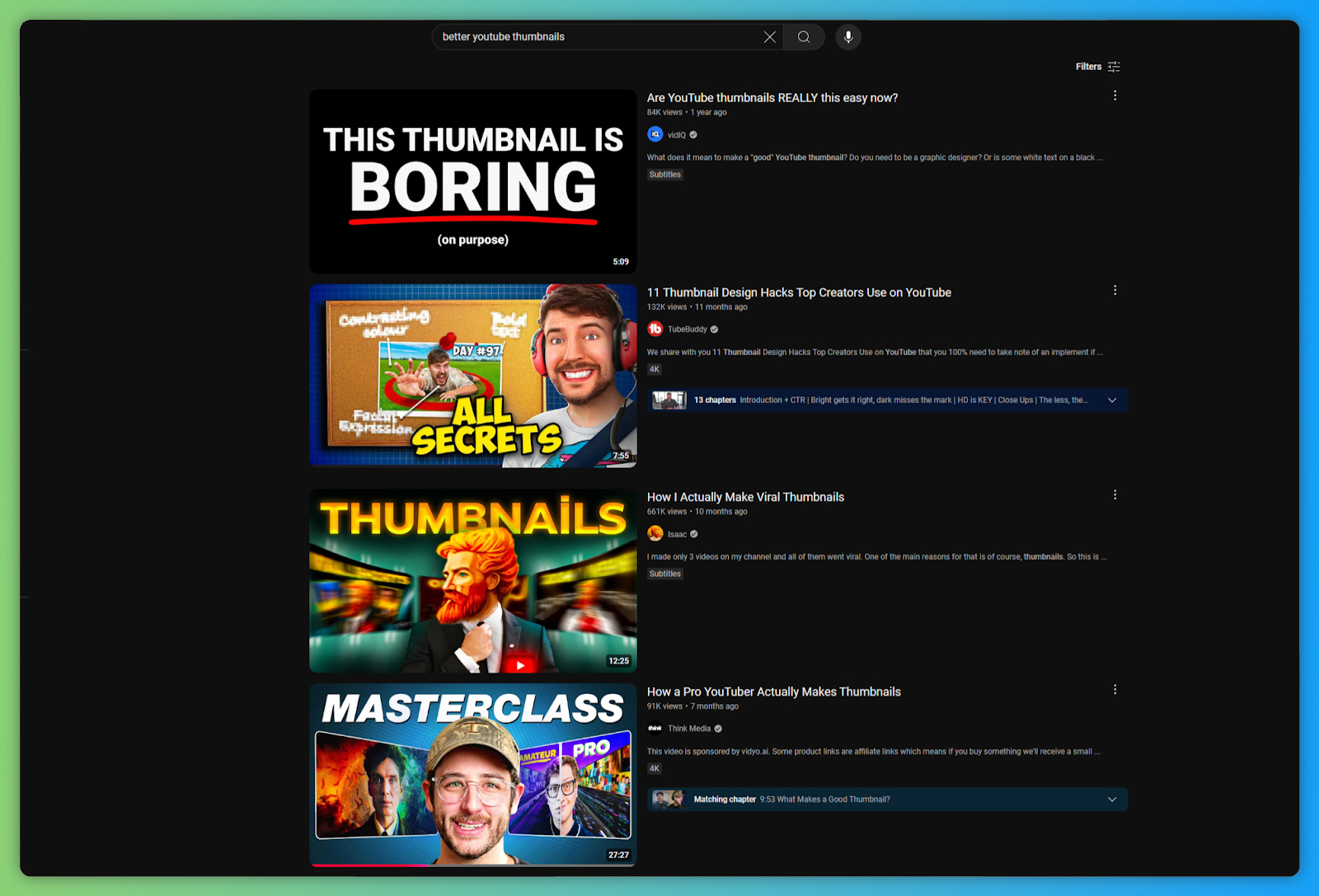Take a look at your YouTube channel—how do you feel about it? If you’re like most UK businesses and creators, it’s probably a bit hit or miss. You’ve got some good and not-so-good content, but you’re improving, defining your message, building a community, and maybe seeing some videos outperform others. But how do you break through and increase YouTube subscribers to achieve serious growth? How do you stand out amid the noise of countless creators and channels? How do you get your content featured in search feeds, recommendations, and homepages of the viewers you want to connect with?
Well, there is a strategy and plenty of tried-and-tested approaches that get results, and that’s what we’re covering in today’s guide. All coming together to make your YouTube marketing campaign much more successful.
Remember, it’s not about having a huge subscriber base (although it can be). It’s about having a community of subscribers that engage, interact, and buy from your business.
Let’s get into it.
#1 – Nail your YouTube SEO
First things first, YouTube SEO, which could also be described as crafting your YouTube videos for the algorithm and making sure they’re platform-ready.
I won’t teach you to suck eggs, but the downside is that YouTube is a massive library filled with videos, and people search for those videos or are recommended based on the user’s likes, watch history, dislikes, and a ton of other ranking factors. YouTube can serve this service by understanding what your video is about, who it’s for, what information it contains, and how good it is based on other metrics.
That’s where nailing your SEO comes into play, and it starts with keywords.
Keyword research: the foundation of YouTube SEO
Keywords are the bread and butter of your YouTube SEO because it does everything I just outlined above, just like it does in traditional search engine SEO.
Within your video, you’ll place keywords in the title, the description, the thumbnail, in the content itself (YouTube automatically transcribes videos so you know they know what’s being said), all screaming what your video is about. These need to be terms and phrases that people are searching for.
Now, the YouTube algorithm is not stupid. It can read what words are in a title and rearrange them to understand what a video is about, but the more accurately you can keep your keyword together, the more likely you are to rank for it.
Of course, other factors are involved, but this is the foundation of that process. Here are a few tools to help you uncover those golden keywords:
- Google Keyword Planner: This free tool from Google is a great starting point for keyword research.
- Ahrefs: A comprehensive SEO tool that provides in-depth keyword data, including search volume, keyword difficulty, and more.
- TubeBuddy: A handy browser extension designed explicitly for YouTube SEO. It offers keyword research tools, video optimisation features, and more.
Pro tip: Focus on long-tail keywords (longer, more specific phrases) relevant to your niche. For example, instead of targeting “marketing,” try “digital marketing for small businesses in London.” This will help you attract a more qualified audience as your content actually speaks directly to them. Yes, this may stop people from New York or Berlin from watching your content, but if you’re not doing business or talking with them directly anyway, what does it matter?
Optimise your YouTube video titles, descriptions, tags and content
Now, with the keywords in mind, put them into your metadata and write your scripts around them. Your keyword should be the core of your video, and everything you say and post should be related to this topic.
This means you not only add the keywords to the titles, descriptions, and video tags but also to the content itself.
For example, if you have a marketing expert answering top marketing questions, this better be a video where an expert sits down to answer top marketing questions. You should say, “Hey, today we’re joined by Frank, a leading marketing expert, who’ll answer some of your top marketing questions”.
This all sounds obvious, but how many times have you clicked on a video, given it a couple of seconds, and then clicked off because it’s not really what you thought it would be?
Or at least you got halfway through, but the video’s gone off on some random tangent, and you’re no longer interested.
Now, I’m not saying you should stuff the keyword in as much as possible. You need to speak naturally and provide a quality experience. The trick to success here is to balance being clear with your keywords and having an excellent foundation to build the rest of your video.
Create engaging thumbnails

We shouldn’t judge books by their covers, but we do. Statistics show that around 57% of US people will buy books based on the cover alone, and about 80% of us are interested because of the cover.
And, of course, we would be. You can’t see what’s inside at that time, and we need a way to make a choice when literally thousands of options are available. It’s precisely the same on YouTube.
This means your thumbnail needs to stand out and do its job.
Now, there are the standard tips here, such as using high-quality images, eye-catching text, and consistency in terms of colours, fonts, and so on with the rest of your brand.
However, some better tips to stand out are in order.
- Make the title align with the thumbnail: The title and the thumbnail will always be seen together, so you can play them together, such as messaging that speaks to each element. For example, you could have a title that says, “You won’t believe this marketing hack”, with a thumbnail with a silhouette or tease of what that thing may be with a big question. They work together to create mystery and intrigue.
- Negativity works better: Across the board, negative-orientated content works better than positive content. It sucks and is a pretty depressive approach, but that’s just what works. That’s why so many creators who criticise seemingly everything get so big. However, use this to your advantage and showcase the problem you’re trying to solve in your thumbnail, and promise the video will teach you how to fix it. For example, if you’re an accountant, show someone broke and quickly show via the title that you’re teaching money management skills in the video. This works better than showing someone rich.
- Keep things simple: Users will make their first impressions of your video (therefore choosing whether to click and watch or not) within a few seconds, so don’t waste time. As a rule of thumb, never have more than five elements in your thumbnail. Text should always be sparingly, never more than a word or two.
- Research your competition: At the end of the day, your competition tries to rank the same kinds of videos as yours. Therefore, you just need to be better than them. See what they’re doing, what approach they’ve taken, and what they’ve done, both good and bad. Then, simply build on it and do what you believe to be a better version.
- Use emotion: Emotion is everything in online content. Through the use of thumbnail elements, text, colour, and so on, showcase an emotion you’re trying to connect with. Red is passionate, anger, and intense. Orange is excitable, energetic and enthusiastic. Blue is corporate, proper, and trust. Use it wisely.
Spend time on your thumbnail, literally more than 30% of your time on it. It doesn’t matter if your video is the best in the world if no one’s clicking on it to watch it.
David Ogilvy, the father of modern advertising, said the same thing when working on headlines. 80% more people read your headlines (and see your thumbnails) than will actually read your content, so make it count.
#2 – Craft high-quality videos (consistently!)
Oh, well, that’s it, right? The tip you came for. Just make better, high-quality videos every time. If only it were that easy!
Well, that is the trick, but the core of your success comes down to how you achieve that. The problem is that we see a lot of businesses trying to reinvent the wheel with every video they post. They believe that they need to come from a new angle that completely revolutionises the type of content they’re producing to stand out.
With the most popular YouTubers, this comes down to shouting louder, going bigger, spending more money, and trying to do something no one can emulate. Great if you’re trying to build the biggest audience possible, but not so much if you’re a business trying to drive growth and sales.
The trick is value. Your value may be unique and have a new angle, but how you present it doesn’t have to be. Let me break it down.
Content is king
Users are always on the hunt for value. They’re choosing where they spend their time and whose content is worth their while. In the business or consumer world, this translates to something that educates, entertains, or inspires them. So, put on your thinking cap and ask yourself: What unique knowledge or perspective can I offer?
Here are a few ideas to get your creative juices flowing:
- Tutorials and how-tos: Share your expertise by creating tutorials or how-to guides related to your industry.
- Behind-the-scenes: Give viewers a glimpse into your company culture or the making of your products.
- Product demos: Showcase your products or services in action.
- Customer testimonials: Let your happy customers do the talking!
- Vlogs: Share your thoughts and experiences in a vlog format.
Now, break your video into a tried-and-tested structure, having a start, a middle, and an end.
At the start, highlight the problem and outline how you’ll solve it. In the middle, explain the solution, back points up with claims, and share your unique expertise as proof. In the end, wrap things up and include a CTA.
You can add fancy graphics, text, effects, expert insights, or whatever you want to get your point across, but this strategic foundation should remain the same because it works. That’s your baseline for sharing your message, and everything else you add should be to share that message more engagingly or make it more accessible. That’s it.
Oh, and remember, quality trumps quantity. It’s better to create a few amazing videos than many mediocre ones. Every video represents your brand, so make sure it’s doing its job.
Production value matters
While on the subject of quality, let’s talk production. Every brand has its own style, but there are some basics to consider. Keep the camera steady to minimise shaking. No one should get motion sickness. Audio is also typically more important than video content. Muffled sound or poor-quality mics are more off-putting than poor video, so get rid of distracting background noise and invest in your mics first.
That said, video is visual, so use visuals. Try to cut every 10-20 seconds to keep things interesting, whether zooming in on a speaking face, showing graphics or stock videos, or changing the scene. This is known as “b-roll”.
Just make sure any content you add is used to help illustrate the point you’re making and convey the core message you set out to send. Filling space with irrelevant content lowers quality.
Some other top considerations include:
- Lighting: Good lighting can make your videos look more professional and visually appealing.
- Audio: Clear audio is crucial! Make sure your viewers can hear you clearly.
- Visuals: Use engaging visuals, like b-roll footage, animations, and graphics, to keep viewers interested.
- Intro/Outro: Consider creating a professional intro and outro for your videos to establish your brand identity.
Consistency is key
While it’s better to have a few good videos than lots of mediocre ones, consistency is key to being pushed on YouTube organically. People need to know what to expect and when to expect it.
Imagine a TV show being aired with three episodes in one week, then one the next week, and then nothing for a month. You’d lose interest rapidly. Same for YouTube.
Consistency is critical for keeping viewers engaged, and hopefully increasing your YouTube subscribers too. But you’ve got to post regularly for the best results, right? True, but it’s better to be consistent and offer quality. This means working out an upload schedule that works for you.
This could be once a month (reserved usually for very high-quality long-form video pieces). Most people will recommend posting once a week. If you can do two a week, that would be even better but don’t sacrifice quality.
Start with one a week (maybe even once every two weeks, say the 1st and 15th of every month), and then if you want to scale to two and you have the resources, then go up.
It’ll have a negative impact to post twice a week and drop down to one because you’re running out of steam and scaling down in the algorithm’s eyes.
So, let’s say once a week, maybe you dedicate a day or ten hours to recording and editing. You could record on Monday afternoon, edit on Wednesday afternoon, and post on Friday.
However, be aware that you don’t want to post in the same week because what if you or a team member goes ill or there are problems? Record some content to get ahead and then go for the schedule.
If you have four videos in the bank (and invest time here and there to record and store to cover, say, if you’re going on holiday), then you’ll reduce the stress of the production process and are far more likely to provide quality, rather than rushing it out.
Make everything routine so you don’t have to think about it.
Once you’ve defined your routine, communicate this with your audience so they know what to expect. Over time, you’ll build a loyal audience who can’t wait to see what you’re releasing next, and this will boost your subscribers!
#3 – Promote your YouTube videos across other channels
We’ve spoken a lot about attracting an audience on YouTube itself, but don’t forget that people can access your videos from all over the world, wherever you choose to share them. And share them you must.
YouTube is such a competitive place, and there’s realistically very little real estate for your videos to show up. Instead, by embedding videos in your blog posts, sharing on social media and via email, and embedding on your website, you’re getting far more eyes on your video. If you’re focusing on quality, then this can translate into new subscribers. But there are some nuances to be aware of.
Social media
When posting to social media, you’re welcome to simply post a new story saying, “Hey, we have a post up, and we think you’ll like it.” It’ll work to a degree, but you can do so much more, especially when you make the most of features like short-form content.
TLDR: Edit your videos to fit the social media platform on which you share them. Tailor your message to each audience. Facebook, X (Twitter), Instagram, and TikTok love short clips, so you can edit previews that tease or highlight a particular point of your video that you can then lead people to go and see the full content.
LinkedIn typically favours text posts, so summarise with text and then link the video or a clip of it at the bottom.
You can even record and edit your videos with this process in mind.
Email marketing
Email marketing is still a powerful tool for reaching your audience. While video content is embedded, it doesn’t really work, nor does just linking it; you can instead repurpose your video content to be a newsletter.
So write 200 words on the problem, highlight how to solve it (sharing the value) and then say, “Hey, we actually did a whole video on this, which you can check out here.”
Nice and simple, you still gave value without being too pushy, and advertised your content in the process. Don’t forget to add a link to your YouTube channel in your email signature.
Website integration
Embed your YouTube videos on your website and blog posts to provide valuable content and encourage visitors to explore your channel. You can even create a dedicated YouTube channel page on your website to showcase your videos and make it easy for people to subscribe. By promoting your videos across different channels, you’ll increase their visibility and reach a wider audience. And the more people who see your videos, the more likely you will gain new subscribers. It’s a simple equation, really!
Want more tips on video marketing and repurposing your videos across multiple channels? Watch our on-demand webinar below:
#4 – Engage with your YouTube audience
Imagine you walk into a shop, and the staff completely ignores you. No friendly greeting, no helpful advice, just blank stares. You’d probably walk right out. The same goes for your YouTube channel. If you want to build a loyal community and attract subscribers, you need to engage with your audience. And I mean really engage.
Respond to comments
Think of your YouTube comments section as a virtual water cooler. It’s a place for viewers to share their thoughts, ask questions, and connect with you.
So, join the conversation. Most people also get a kick out of being recognised by a channel they comment on, and they are far more likely to hang around for the next video since they feel more connected to you. Remember to be:
- Responsive: Reply to comments and questions promptly.
- Helpful: Provide valuable insights and answer questions thoroughly.
- Personable: Show your personality and build relationships with your viewers.
Collaborate with other YouTubers
Think of YouTube collaborations as a virtual networking event. By teaming up with other YouTubers in your niche, you can reach new audiences and gain exposure to potential subscribers.
- Find YouTubers with a similar audience: Look for creators who share your target audience but offer different content.
- Create collaborative videos: Co-create mutually beneficial and engaging videos for both audiences.
- Cross-promote each other’s channels: Mention each other in your videos and include links in the descriptions.
By engaging with your audience, you’ll create a sense of community and make viewers feel valued.
And guess what? Valued viewers are more likely to stick around and subscribe.
#5 – Run YouTube ads
While organic reach is fantastic, sometimes you need a little boost to get your videos in front of the right people, which you can do with YouTube Ads. But this is a double-edged sword.
Most notably, so many people run a lot of spammy, manipulative ads that don’t really show what they’ve offered (or straight-up lie about it), and this has given ads a bad name. Aka, a lot of people can just flat out ignore them.
However, focusing on quality and proper targeting can be an effective way to get your video in front of more people and, in turn, increase your YouTube subscribers.
Targeted advertising
Through YouTube’s built-in targeting capabilities, you can narrow down your audience based on demographics, interests, and even specific keywords they’ve searched for. This ensures your ads are seen by people interested in what you have to offer, and you hit the bullseye with who’s seeing your content.
- Demographics: Target your ads based on age, gender, location, and other demographic factors.
- Interests: Reach people who have shown interest in topics related to your videos.
- Keywords: Show your ads to people who have searched for specific keywords on YouTube.
- Remarketing: Target people who have already interacted with your channel or videos.
Different ad formats
YouTube offers a variety of ad formats to choose from. Here are a few popular choices:
- Skippable in-stream ads: These ads play before, during, or after other videos. Viewers can skip them after 5 seconds.
- Non-skippable in-stream ads: These ads must be watched before viewing the video.
- Overlay ads: These ads appear as a semi-transparent overlay at the bottom of the video.
- Bumper ads: These are short, non-skippable ads up to 6 seconds long.
Experiment with different ad formats to see what works best for your goals and budget. And don’t forget to track your results to see which ads drive the most subscribers.
#6 – Leverage YouTube analytics
Studying your analytics is vital to your success because it tells you what you’re doing right and what you need to improve on. This means no guessing what video content you should make next or how to make it and more data-driven decision-making.
However, first of all, get rid of the focus on vanity metrics. Even subscriber counts mean nothing if no one engages with your content and you aren’t getting sales. This is why buying subscribers is a waste of time and can get you penalised.
Note: There’s an argument that can be made that if you have more subscribers, people will see your channel as being more legitimate and credible, but that’s negligible.
What you should focus on is seeing how people engage with your videos to gauge how they’re being received, which topics we do well on, and who your audience is.
If you have a SaaS product that can help businesses with their accounts, but it turns out your analytics show that accountants are the only people picking up your software to help them with their jobs, it may be worth pivoting to accounting-based videos that attract more people like this.
Let’s break it down.
Track your progress
YouTube Analytics provides a wealth of data about your videos, including:
- Watch time: How long are viewers watching your videos?
- Audience retention: Where viewers are dropping off in your videos.
- Click-through rate: How often people click on your videos after seeing them in search results or recommendations.
- Traffic sources: Where your viewers come from (e.g., YouTube search, social media, external websites).
You can identify what’s working and what’s not by tracking these metrics. Adapt accordingly, and make small changes at a time so you can find the perfect formula for your videos.
For example, if most people are dropping off at the two-minute mark, you may need to speed this section up, add some cuts to make the content more engaging or do something else to keep people focused.
Understand Your Audience
YouTube Analytics also provides valuable insights into your audience, such as:
- Demographics: Age, gender, location, and interests of your viewers.
- Viewing habits: When and how often your viewers watch your videos.
- Popular content: Which of your videos are performing the best?
This information can help you tailor your content to your audience’s preferences and create videos they love. Same as we said above.
#7 – Don’t forget calls to action
People these days don’t like to think too much. Not in a mean way; there’s just so much content out there all vying for their attention that they simply don’t have time.
When it comes to the end of your video, you want to place a clear CTA that tells them what to do next. If you come across as genuine and they’re interested, they’re much more likely to say, “Yeah, I’ll do that, actually”.
Use them wisely.
Verbal CTAs in videos
Don’t be shy about telling your viewers what you want them to do. Whether it’s subscribing to your channel, liking the video, leaving a comment, or sharing it with their friends, make sure to include clear and concise verbal CTAs throughout your videos.
- Be enthusiastic: Your enthusiasm will be contagious!
- Be specific: Instead of just saying “subscribe,” say “Hit that subscribe button so you don’t miss any of my future videos!”
- Repeat your CTAs: Mention your CTAs multiple times throughout the video, but don’t overdo it.
Visual CTAs
YouTube offers some handy tools to visually reinforce your CTAs:
- End screens: These appear in the last 5-20 seconds of your video and can be used to promote other videos, playlists, or your channel.
- Cards: These interactive elements can be added to your videos to promote other content or encourage viewers to take specific action.
- Subscribe button overlay: This is a small subscribe button that appears on your videos, making it easy for viewers to subscribe.
By using a combination of verbal and visual CTAs, you can effectively guide your viewers towards taking the actions you want them to take, including subscribing to your channel.
#8 – Community engagement beyond your YouTube channel
When it comes to the YouTube community, it’s a bustling network, and while your channel is an excellent operating stall, there are others around you, and people care about these others.
If you’ve ever been on a YouTube video and seen another big channel commenting on the video itself (YouTube does this all the time with their official channel, much to the amusement of the viewers), you’ll have seen this for yourself what sort of feeling this creates.
Therefore, to thrive yourself, you need to be a core part of the buzz of the network, not just quiet in the corner. You’re not there to do that.
Engage with relevant content
Don’t just sit back and wait for people to find your videos. Be proactive and engage with other content in your niche.
Comment on other videos: Leave thoughtful comments on videos that you enjoy or are relevant to your audience.
Participate in YouTube communities and forums: Connect with other creators and viewers in your niche.
Build relationships with viewers
YouTube isn’t just about views and subscribers; it’s about building relationships. Connect with your viewers personally and make them feel like they’re part of a community.
Respond to comments and messages: Show your viewers that you care by responding to their comments and messages.
Connect with viewers on social media: Engage with your viewers on other platforms and build relationships beyond YouTube.
By actively participating in the YouTube community, you’ll increase your visibility, build relationships with other creators, and attract new subscribers.
#9 – Consider YouTube’s paid features to help increase subscribers
Alright, we’ve covered a lot of ground already, but there’s one more trick up our sleeve: YouTube’s paid features. Sure, if people are paying for your content, then they’re probably already subscribed, but for people coming to your channel to see die-hard fans and lots of premium-level content, donations, and the sorts, it shows you know what you’re doing, and you’re credible.
Social proof is everything these days, and if users see other people locked in and loving what you’re offering, then the chances are they’ll want to be a part of that. Therefore, it’s well worth looking into what’s on offer.
Channel Memberships
Want to create a loyal fan club? Channel memberships allow viewers to join your channel as paying members, giving them access to exclusive content, perks, and badges. It’s like having your own little inner circle on YouTube.
- Exclusive content: Offer members-only videos, live streams, or behind-the-scenes content.
- Perks: Give members access to custom emojis, badges, or other perks.
- Community: Create a sense of community among your members.
Super chat and super stickers
If you’re doing live streams, Super Chat and Super Stickers are a fun way to monetise your content and engage with your viewers. They allow viewers to pay to have their comments highlighted in the chat, making them stand out from the crowd.
Well worth thinking about, especially if you want to talk about trends, engage with users, host podcast-type content, and the sorts. Get creative with it.
Summary on how to increase your YouTube subscribers
As you can see, these aren’t individual strategies but a complete roadmap to growing your YouTube channel.
And remember, it’s not about subscriber counts, although they can be helpful. It’s all about nurturing loyal superfans that love your business and they themselves, through comments, recommendations, views, and the sorts, they encourage more people to join the cause.
Now, it’s time to put everything into action. Sit down with your team and create a plan. The plan can change and evolve over time, but start with the basics, create a schedule, and implement it.
Don’t be afraid to experiment and see what works best for your channel and your audience. But don’t forget consistency is key, so keep creating amazing content and engaging with your viewers.
And most importantly, have fun! YouTube is a fantastic platform for expressing your creativity and connecting with people from all over the world.
Best of luck, and for our own CTA, if you’re looking for high-quality video content for your business contact our video production team here at LOCALiQ, or alternatively explore our video services page.





